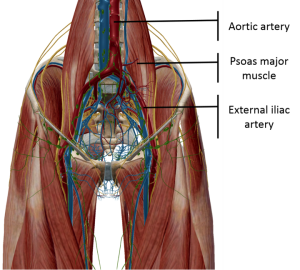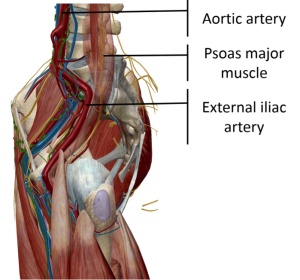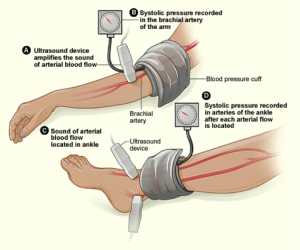The Danger of the Drops- A Review of Peach et al. 2011
A Question
Bradley Wiggins broke the world record for longest distance covered on a bicycle in one hour by riding 54.526km on June 7th, 2015. Because 90% of the resistance when biking on a level surface above 12mph comes from air drag and 70% of that drag comes from the rider [1], significant attention was paid to finding the most aerodynamic bike fit possible for Bradley. Among other things, this position included a lot of forward bend and flexion at the hips.
As a bike fitter in Oakland California, I spend a lot more time fitting people to climb hills than to time trial, but I do see a fair number of triathletes for whom the generally level cycling courses make aerodynamics paramount. I've heard that spending a lot of time exercising in this bent over position can cause thickening of the walls of the large arteries in the abdomen.
When I fit someone in an aggressive amount of hip flexion and forward bend, am I putting them at risk for vascular damage? As usual, I turned to the research literature to find the answer.
Some Data
A group of vascular surgeons and sports scientists in the UK and Netherlands published a systematic review on all the research on iliac artery damage during endurance exercise [2]. They found 47 relevant studies, the highest quality studies were case-control studies with no randomized controlled trials found on the topic. Most of the cases they found were of young endurance athletes with exercise induced cramping that didn't improve with physical therapy. What was going on with these athletes? To understand this problem, we'll need to cover a little anatomy first.
Where is the external iliac artery?
The external common iliac arteriers are a pair of large blood vessels that come off the aorta and the external iliac branch supplies fresh oxygenated blood to the legs. All the blood to the quads, lower hamstrings and everything below the knee comes from this artery.

Image from the Visible Body ipad app
What limits blood flow in the iliac artery in otherwise healthy endurance athletes?
Endofibrosis is a thickening of the inner wall of the blood vessel called the tunica intima. This thickening makes the internal diameter of the blood vessel smaller and thus limits blood flow. The thickening is usally 2-6cm long and 90% occur in the external iliac artery. Most cases (85%) occur on only one side of the body with the left begin more commonly affect than the right (52% to 90% left sided depending on the study).
What causes endofibrosis of the external iliac artery?
Many causes have been proposed, here are the most common
- Repetitive stretching and bending of the arteries while exercising in a bent-over position.The problem is most common in speed skaters and endurance cyclists.
- Enlargement of the psoas muscle under the external iliac artery.The larger the psoas muscle the more it will push up on the external iliac artery, causing it to bend at a sharper angle. Cyclists with endrofibrosis have been found to have a thigh circumference 3cm larger on the affected side.
- Fixation of the psoas muscle.Excessive fascial connetions, scar tissue or even the extra blood vessels the grow into the psoas from training can tether the artery and make it kink.
- Unusually long iliac arteries.A longer artery has to kink more to fit in the same space. The length of the artery is most likely genetic. A very long artery can cause kinking that limits blood flow even without endofibrosis.
- Unique systemic factors.Diabetes compromises the vessel walls. Abnormal methionine metabolism has been found in 75% of one cohort of patients with endofibrosis

This image from the Visible Body ipad app shows how the external iliac artery makes a sharp turn along the back side of the abdomen before exiting the front of the pelvis.
How Common is Iliac Artery Blood Flow Impairment?
In the general population the condition is very rare, in elite endurance athletes it may be as high as 10-20% although the difficulty in diagnosis make estimates uncertain. A survey of cyclists with the condition found that:
- All of the cyclists had ridden an average of 9,009-12,427 miles per year (14,500 to 20,000 km/yr) for many years. That's 173 to 239 miles per week year after year.
- 88% were men, but this may be skewed by the fact that there are more male elite endurance athletes
This rare condition is most common in cyclists but has also been reported in other sports with a bend-over posture such as speed skating, and cross-country skiing, but a few cases have been reported in sports that are more upright such as endurance running, rugby, soccer, and body building.
Am I at risk?
The most common symptom is a cramp and a feeling of swelling, numbness or pain in the buttock, thigh or calf on one side of the body. The pain may be mild. Professional cyclists Hayden Godfrey described his symptoms of endofibrosis as feeling like his leg was falling asleep and losing power. Because these symptoms are somewhat vague and tend to go away after exercise and because endurance athletes are accustomed to feeling discomfort in their legs, people tend to go un-diagnosed for a long time.
Fortunately Schep et al. reviewed the research and found that when all of the following four signs and symptoms were present, they were able to correctly diagnose iliac endodfibrosis 79% of the time [3].
Four signs and symptoms that leg cramping, swelling, numbness or pain is coming from endofibrosis:
- The complaint goes away less than 5 minutes after stopping exercise. More than 3 out of the 6 major leg muscles are involved. (sens: 0.97, spec: 0.29)
- More than 3 out of the six major muscle of the leg are involved (sens: 0.48, spec: 0.94)
- Femoral bruit with hip in extension- Abnormal blood vessel sounds found using a stethoscope (sens: 0.36, spec: 0.94)
- Normal lower back flexibility (sens: 0.91, spec: 0.29)
What is the treatment?
If you are concerned that you may have this condition, schedule an appointment with your doctor to discuss it. Further testing may be warranted such as measuring blood pressure at the arms and ankles immediately after cycling. Treatments vary depending on the cause of the blood flow restriction.
Ankle Brachial Index- Wikipedia Creative Commons

Blood pressure is compared between arms to detect arterial blood flow limitations. Wikipedia.
For minor cases in cyclists the following treatments are often sufficient:
- reducing the hip flexion angle by
- spending less time in the drops
- moving the saddle forward
- raising the handlebars
- reducing psoas hypertrophy by not pulling up on the pedals
- reducing riding time
Ryan Cox- Wikipedia creative commons license
More severe cases may require one to give up cycling or undergo surgery to continue cycling. Many professional cyclists have undergone surgery for arterial endofibrosis and have returned to professional competition without incident. However, Ryan Cox's tragic death on August 1st 2007 at age 28 from endofibrosis surgical complications is a painful reminder of the risks of this condition.
Conclusion
I think it is worth emphasizing that this is a rare condition outside of professional cycling and speed skating. If you are cycling less than 173 miles per week and/or your position is not extremely low (ie your thigh is not hitting your chest) then it seems you have little to worry about. It is the combination of a low position and high mileage that increase the risk for this condition. Elite cyclists and high mileage recreational riders (ie Iron Man triathletes) should take any lower extremity symptoms seriously and seek medical attention as the condition does not improve on its own.
References
- Burke,E. Serious Cycling 2nd ed. Human Kinetics 2002
- Peach- Endofibrosis and Kinking of the Iliac Arteries in Athletes- A Systematic Review. 2011
- Schep G, Schmikli SL, Bender MH, Mosterd WL, Hammacher ER, Wijn PF. Recognising
vascular causes of leg complaints in endurance athletes. Part 1: validation
of a decision algorithm. Int J Sports Med 2002;23(5):313e21 - Schep G, Bender MH, Schmikli SL, Mosterd WL, Hammacher ER, Scheltinga M,
et al. Recognising vascular causes of leg complaints in endurance athletes. Part
2: the value of patient history, physical examination, cycling exercise test and
echo-Doppler examination. Int J Sports Med 2002;23(5):322e8
- Featured image: "Bradley Wiggins Hour Record" by Andrew Last. Flickr Creative Commons
About the Author: Bryan Ausinheiler is a physical therapist, personal trainer and bike fitter with a clinic and studio in Oakland California.
